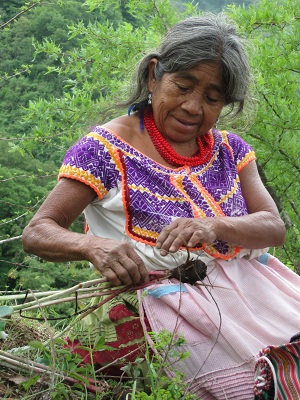Documentation of Chatino

Landing page image for the collection “Documentation of Chatino”. Click on image to access collection.
| Language | Santa Cruz Zenzontepec Chatino, Tataltepec Chatino, San Juan Quiahije Chatino, Yaitepec Chatino |
| Depositor | Anthony Woodbury, Eric W. Campbell, Emiliana Cruz, Hilaria Cruz, Justin McIntosh, Stéphanie Villard |
| Affiliation | University of Texas at Austin |
| Location | Mexico |
| Collection ID | 0090 |
| Grant ID | MDP0153 |
| Funding Body | ELDP |
| Collection Status | Collection online |
| Landing Page Handle | http://hdl.handle.net/2196/8bfd3fbd-bf94-4e86-8d00-4bb7a4c8287f |
Summary of the collection
A collection of audio- and video- recordings of narratives, interviews, conversations, oratory, ritual speech, linguistic elicitations, and other genres in all major varieties of Chatino. The collection also includes transcriptions, translations, and annotations of some of the recorded texts; data sets, word lists, and analyses; academic papers and pedagogical materials.
Group represented
Chatino cultural group. Chatino is a group of language varieties forming an independent genetic unit within Zapotecan. Chatino is spoken by most of the 29,000 Chatinos of Oaxaca, Mexico’s, Sierra Madre, the mountains between the valley of Oaxaca and the south-facing Pacific coast. The highlands, reaching slightly more than 2000m, are cool and wet, especially during the summer and fall; while the lowlands are hot, humid, and lush. Juquila, in the highlands, is a predominantly mestizo town and is the governmental hub for the entire region. Together with Nopala, in the lowlands, it is also a commercial and transportation center. Puerto Escondido, on the coast, is outside the Chatino region proper, but attracts many Chatinos as workers in its tourist industry.
The Chatino region is surrounded by traditionally Zapotec-speaking communities to the east, north, and northwest; and Mixtec-speaking communities to the west and southwest. Along the Pacific coast itself, communities are ethnically mixed and are Spanish speaking.
Despite its internal diversity, speakers normally call all varieties ‘Chatino’, making it possible to say about a speaker of another variety, ‘I can’t understand her Chatino.’ That is, language identity is projected from a common Chatino ethnic identity, rather than from any reckoning of mutual intelligibility among the various Chatino varieties.
Language information
Santa Cruz Zenzontepec Chatino (czn), Tataltepec Chatino (cta), and the following varieties of Eastern Chatino: San Juan Quiahije Chatino and Yaitepec Chatino (aggregated in ISO-639-3 as “Western Highlands Chatino (ctp)); Zacatepec Chatino (ctz); Teotepec Chatino (aggregated in ISO-639-3 in “Nopala Chatino” (cya)); San Juan Lachao Chatino (aggregated in ISO-639-3 in “Eastern Highlands Chatino” (cly))
Acknowledgement and citation
To refer to any data from the collection, please cite as follows:
Woodbury, Anthony, Eric W. Campbell, Emiliana Cruz, Hilaria Cruz, Justin McIntosh & Stéphanie Villard 2011. Documentation of Chatino. Endangered Languages Archive. Handle: http://hdl.handle.net/2196/00-0000-0000-0001-BBFF-F. Accessed on [insert date here].


